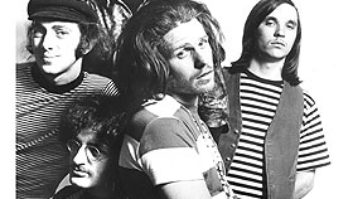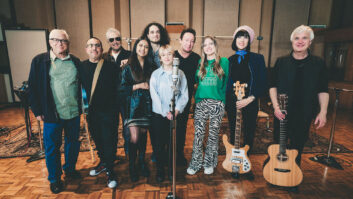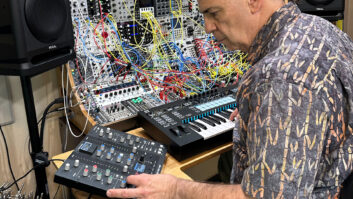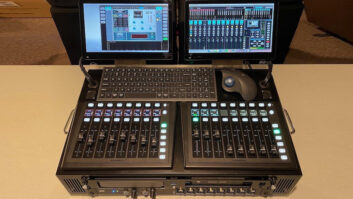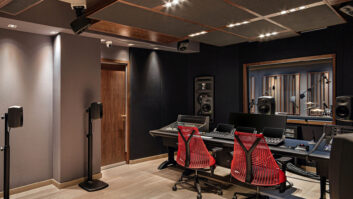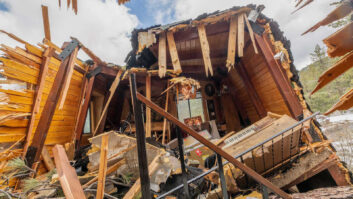America is currently in an “on” phase of its on-again, off-again love affair with roots music, largely thanks to the much-deserved success of the O Brother, Where Art Thou? soundtrack. It seems that once every decade or so, a new crowd discovers Chicago blues, Louisiana zydeco, country swing or mountain music. But for some music lovers, roots music is a lifelong mission; Arhoolie Records owner/founder/producer Chris Strachwitz is one of those dedicated few. He has made American, and other nations’, vernacular music his life’s work.
Strachwitz was born in Germany in 1931, and moved with his family to Northern California in 1947. His love of roots music grew from the blues, country and Mexican music he listened to on the radio. He became then, and still is, a passionate record collector, and began satisfying his musical obsession by amassing an ever-growing collection of 78s of what he calls “low-down music.”
It wasn’t long before Strachwitz developed a burning desire to record the type of music he was always looking for, especially his idol, Lightning Hopkins. Having learned some recording basics from his friend, Bay Area recordist Bob Geddins, Strachwitz made his first field trip to Texas in 1960 with the goal of recording Hopkins and other talent that his sources and his ears might reveal. It was the beginning of the career of one of America’s most significant field recordists. For more than four decades, Strachwitz has made hundreds of recordings by now-well-known Southern artists such as Hopkins, Clifton Chenier, Fred McDowell and Del McCoury, as well as Mexican-American musicians like Flaco Jimenez and Lydia Mendoza. This year, a boxed set that surveys Arhoolie’s history, Arhoolie Records 40th Anniversary Collection, 1960-2000: The Journey of Chris Strachwitz, received the Grammy for Best Liner Notes by Elijah Wald.
But Strachwitz’s main motivation was never to garner fame or fortune for himself or for the artists. He is driven by the joy of chronicling and collecting roots music at the source — not in studios, but, as Alan Lomax did, in living rooms and backyards, onstage or on the front porch. He is also very involved in the preservation of the old records he has collected and has formed the nonprofit Arhoolie Foundation to focus on that work. Recently, Strachwitz began a project — funded through UCLA by the Los Tigres del Norte Foundation — to restore thousands of pre-tape recordings by Mexican and Mexican-American performers. It’s truly remarkable that someone who has been doing it for love for 40 years has lost none of the joy of discovery that fired him up in the first place.
When you were first starting out making recordings, were you very aware of other field recordists who had gone before you, and were you influenced by their work?
I was familiar with Alan Lomax, and the main people who really inspired me were these local, small operators, including Bob Geddins here in Oakland [Calif.], and a guy named Mr. Jaxyson, who also lived in Oakland. And down in Houston, I met Bill Quinn, who had Gold Star records in the late ’40s and early ’50s. In Lake Charles [La.], I met Eddie Schuler, who had Goldband records and who was recording all kinds of cajun music. I heard this rhythm & blues on the radio in the early ’50s, and I said, “My God, this is really gut-bucket music.”
But by that time, all kinds of field recordings were being made, including a lot of great New Orleans jazz, which I admired greatly. I was a total fan of Bunk Johnson and George Lewis, and Bill Russell was an old-timer who had devoted his life to recording the authentic New Orleans jazz musicians, and he was still doing it on 78s. Most of these guys, when I started, were just switching over to tape.
What did you make your early recordings on?
On tape. I wish I’d had the money to get an Ampex right off, but I didn’t, so I made a big mistake and bought a cheap Japanese copy. I bought a Roberts; everybody told me it sounded like an Ampex. Well, the damn thing started overmodulating within a year that I had it. They’d apparently left all of the expensive parts out of the Ampex. It functioned, but the electronics were terrible. Then, slowly, I worked my way up. I used an Electro-Voice 636 mic. I couldn’t even afford a 666, which was much better.
Where did you make your early recordings?
Mostly in Texas, and I did a few here in California, and then in Dallas-Fort Worth, Houston…and I traveled over to Louisiana. In Baton Rouge, I recorded some stuff, and some in Mississippi, and so on.
What type of venues?
It was mostly in people’s houses, except I caught some of the early zydeco people who were just beginning to kick into gear in Houston at that time. This was in ’60, and nobody had ever heard of this stuff except in these few beer joints down there. I was lucky to meet up with this fellow Mack McCormick, who lived in Houston and was not only trying to be Lightning Hopkins’ manager, but he also knew a lot about the scene, the ethnic music in Houston.
My other informer was Paul Oliver, the British blues writer who I met up with in Memphis that same summer. He had sent me an amazing list of musicians, mostly blues, who had recorded in Dallas-Fort Worth in the ’20s and ’30s. And so when my friend Bob Pinson and I came into Fort Worth, we’d start asking for people, like detectives on a street corner.
The trouble was the names that Paul had sent me didn’t mean anything to me, because I had never heard of these people, except they did have colorful names. Anyway, I just stopped these guys playing dominos on a street corner and asked them, “Any of you ever heard of Little Brother?” And they all looked at me as if I was from Mars, and they said, “What you want with him?” They probably all thought I was the police or a bill collector, and I said, “Well, I got this record by him, and I kind of like the way he plays guitar and sings blues.”
So, one guy comes over and says, “Well, he hangs out with Black Ace,” and Black Ace was on my list from Paul Oliver. “So, where could I find Black Ace?” “He comes into this tavern that’s right down the street here. You can’t miss him. He has a white shirt on with a big ‘Ace’ written over his pocket. He comes in at 5 o’clock.”
Sure enough, I went back at 5 o’clock, and there’s this big black man with a white shirt on and ‘Ace’ written on it. I said, “Are you Black Ace?” He said, “Yes, sir.” That’s how we found Black Ace. I never did find Little Brother.
We also looked for Little Son Jackson. We knew his name was Melvin, because that was the composer credit given on the 78 we had. We looked in the phone book, but there was no such person, but then Pinson said, “[Let’s go back to] when he was going big, let’s say around ’51.” So, we went to the library and looked in the old phone books, and there was a Melvin Jackson, and we found him. He had quit the music business because he had been in an accident, and because he had enough of it. He was a very shy person, and he was working for an auto parts place, and that’s where we met him. And I recorded some of his things in his house.
How did you convince people to make recordings with you then?
If they were already commercial artists, I had a problem. I think I had $1,000 for the whole trip in my pocket, and when Son Jackson said, “Well, I want $1,200 for that many songs,” I said, “I just can’t afford it.” So, he said, “Let’s make a few,” and I gave him something and told him when it came out that I’d try to pay him the rest.
I had the same problem with Lightning Hopkins. He was used to getting $100 a side, so I never succeeded in recording him that first trip, but since Lightning was running off to go to California, Mack McCormick said, “Chris, you’ve got a car. I bet there’s more people like Lightning out here in these woods someplace.”
So, I stopped along the highway where all these people were chopping cotton, and I asked them, “You know of any guitar pickers in these parts?” They said, “Well, you gotta go to Navasota for that.”
And that’s where you found Mance Lipscomb, the artist on your first album. Had he ever made a record before?
He had never made any recordings, so he didn’t really ask for any money. He was sort of scared of us, I guess.
What did you do to set him at ease?
I think we obviously knew this music. At first, he played “Shine on Harvest Moon,” because he thought that’s what all the white folks wanted to hear. But we wanted the real stuff like “Tom Moore’s Farm,” and he loved to play. And when we left, we put whatever little money I had — I think it was $35 — in his hand. That’s all I had on me right then, and I told him we’d probably be coming back.
When we came back, he said, “I gave that $35 to my wife, and she said, ‘Well, I’ll be doggone. Them people paid you more than you ever made playing that damn guitar.’” So, to her it was a whole lot. We developed a nice thing with Mance, and it was Mack who told me on the way back to Houston, “Chris, you ought to put this out as your first record, because this is really pre-blues; this is probably the most important person you’ll ever find.” And although I didn’t really care for his music all that much, I was totally impressed by the man.
Why didn’t you like his music?
This was sort of sweet folk music; that isn’t exactly what I was after. I wanted alley blues like Lightning — drunk, nasty stuff. I had heard Lightning the year before, you see, and I was totally knocked out. This guy could improvise in these beer joints as to what was happening to him that day. I had never heard anything like it. It was also the last time that he was that kind of a bard for his own neighborhood, so to speak. Once he started traveling and realizing that the white folks liked his stuff, but they wanted the old records that he made, he had to relearn all this stuff and make an act out of it.
When did you finally get to record Lightning Hopkins?
It was about two years later, when he came to California. I had met him and hung out with him. I was like a puppy dog. I couldn’t get enough of that cat, because it was something I had never encountered before. And then, one night back in Houston, he said, “You want to go hear my cousin?” And I said, “Oh, sure.”
I said, “Who’s your cousin?” He told me he was named Cliff Chenier. Well, to me, that was an R&B artist, because I had known his record of “Ay Te Fee” on Specialty. To me, that wasn’t really low-down blues. But anyplace Lightning wanted to go, I’d go, so we went to French Town in Houston. We walked into this little beer joint, and here was this black man with this big accordion strapped on his chest and just a drummer backing him up and playing the most low-down blues I’ve ever heard on a damn accordion, except he was singing in this weird patois I’d never heard before, and I was totally knocked out by it. I mean, he put in so much soul it was scary. So, Lightning introduced me, and Cliff said, “Oh, you’re a record man. Let’s make a record tomorrow.” He hadn’t had a single in some years, so he figured any white guy that’s in the record business, that must be it. I finally agreed. We went over to Bill Quinn’s studio.
So, you recorded with his equipment?
Yeah, but what showed up the next day was not only Clifton and his drummer, but he brought his whole damn band. And he said, “Well, you know Chris, that old French stuff isn’t hitting. I gotta make rock ‘n’ roll records.” I said, “Well, I don’t know. What I heard last night knocked me out; I didn’t care for that ‘Ay Te Fee’ so much.”
Anyway, he had a drummer and a guitar player and an electric bass man and a piano player, and, well, thank goodness the bass literally didn’t work because the whole damn paper on the cone of the bass amplifier had come off. And the guitar player’s amp started smoking; it was an old military surplus, and it went out. So, we were down to piano and accordion.
You were getting closer to what you wanted.
We were getting closer, except for the repertoire. He didn’t want to do that French stuff. So, we did “Ay Ay Ay,” and I forget the other side. It was just a single. And then I wrote to him and said I wanted to go back next year and record an album, because this was really unusual music, but I said I wanted the French stuff.
He said, “Okay, I’ll make you a deal. We’ll do half the album in French and half what he called rock ‘n’ roll. Well, the good thing was, he did this one number singing in French with just the drummer and his brother on the rub board, and he came popping out of the studio and said, “I gotta call my old lady; she’s got to hear this one.” Bill Quinn was standing behind me and said, “Chris, that’s going to sell down here; it’s got that sound.”
So, after he talked to his old lady and let her hear it, I said, “Clifton, what am I going to call it?” He said something in French that means something like “Every night is not the same.” I said, “How do you spell that?” And he said, “Any way you want to,” but I don’t speak French and asked, “Can I just call it ‘Louisiana Blues’?” It was probably the smartest thing we ever did, because if we had put that French name on there, the jockeys probably wouldn’t have played it. But this way, they put it on, and the first note just killed you. You just heard that unbelievable low-down song, and it doesn’t really matter which language he’s singing in.
Once you started to have some success, did you upgrade your recording rig?
I started using a Magnacord, a big, heavy machine. It was great, and I used it for a lot of years, though I almost busted my back lugging it around. I think it weighed like 80 pounds, and the handle on it was kind of in the middle of the damn thing, so it was just awkward to carry.
This is still in the ’60s, right?
Yeah. And I used that until the ’70s.
What mics would you have been using at that time?
I used a single microphone, a condenser mic called a Capps. There was a woman named Miss Capps who produced this microphone. I didn’t really use stereo, just that one microphone. That’s what I recorded Fred McDowell with, the Hackberry Ramblers, and a whole bunch of stuff. I would hang it from the ceiling for a group; for Fred, I just put it in front of him.
I continued with that until the ’70s. Now, as much as I collected live music, I collected old records, and by that time, I had built up a warehouse full of duplicates. A Frenchman, a collector, wanted to buy some [78s], and he paid me something like $1,500. I have an uncle who lives in Switzerland, and I had heard that the Nagra company was in Switzerland, and I wrote to him and said, “I’m coming over there, and I’m wondering if you could take me by the Nagra company.” If you were a Swiss resident, you got an incredible deal. I bought a Nagra 4S — that’s a stereo model they had just come out with — for something like $800 or $900, and I bought two Sennheiser microphones, and I recorded in Austria right after that. That was my first trip of recording some Austrian regional music. I got two Neumanns then, too — two 87s — and then I recorded Michael Doucet and Mark Savoy and a whole lot of cajun people with that Nagra.
A lot of the new music coming from Arhoolie now is Mexican conjunto music.
I really want people to hear two of these Mexican records I just did [Los Pingüinos del Norte and Los Alacranes de Durango], though if they knew how I recorded them, most people would probably be horrified.
Why horrified?
Well, because I recorded them with my videotape machine because I could easily carry it across the border. These guys, none of them could cross over to this side. And somebody told me to try this Audio-Technica microphone; it’s a stereo mic, an 8825 or something like that, and I had never really used it. But I recorded two little sessions by both these groups, and I liked the sound I got.
Where did you record?
One was in a bar and the other one was outdoors. I love to record outdoors, but in Mexico that’s not easy, because they have constant trucks and cars and things making noises. I recorded The Pingüinos once in a park under a bridge, and the other time was in their backyard. I think it sounds really good.
I realized immediately that there’s a strong automatic limiter in that video recorder, but these guys just kicked in, and I thought, “Man, this just sounds like Mexican radio; that presence is all there!”
Next time, I might try to take my DAT recorder, because it doesn’t have that heavy limiting, but the heavy limiting may have been what made it sound so good because it really pumps it up, you know? Some fancy studio engineer would probably say it sounds like shit to them, but they’d probably think the music is shit anyway.
Has your style changed much over the years?
No, probably not. I like kicking music. Let’s just get it together. If you have to do two or more takes, I say forget the damn thing.
Barbara Schultz is the senior associate editor of Mix.
